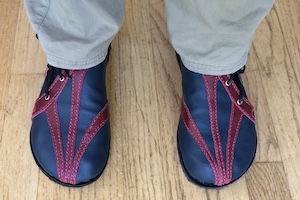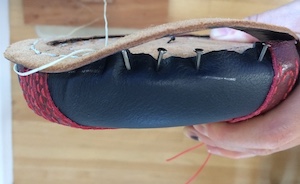Making my own footwear

Beam me up Scotty? I don’t think anyone else has a pair of shoes identical to these! (And because they are handmade, the left shoe is not 100% identical to the right). The strong red patterns fool the eye into not noticing the very wide toes.
I started making my own shoes, boots and sandals because every pair I bought hurt my feet.
Footwear should (but mostly doesn't):
- give toes room: the toe area should be at least as wide as the ball of the foot
- have flat, flexible soles with no raised heels or toe spring
- attach firmly but not too tightly
So-called minimal or barefoot styles are much more likely to have these features. But in my experience, many still don't have a wide enough space for the toes: they pull toes out of alignment.
Conventional footwear almost always has some combination of tapering toes, raised heels, stiff and/or cushioned soles, and toe spring: all characteristics that cause all kinds of foot problems.
In other words, almost all of the footwear you can buy will harm your feet if worn for months or years, and so ruin your health.
If you can't buy it, you need to make it
I want to wear footwear that:
- Let my feet move as they do when barefoot: not stressing joints or causing bad posture.
- Has flair: comfortable shoes don't have to look ugly!
- Can be repaired: too many purchased shoes have to be thrown away because of minor issues. This is a waste of the planet's limited resources, although it's very good for the profits of commercial shoemakers: it's a type of planned obsolescence.

For this shoe, I used a welt to hand-sew the upper to the sole. This produces a very neat result, but is a time-consuming technique that requires specialist tools. Stitchdown and moccasin techniques need fewer tools and less time.
Back in 2015, the only shoes I could buy that didn't make my feet throb were a pair of fluorescent yellow minimalist running shoes (made by Altra, no longer available). More about the foot issues I was experiencing.
So in desperation, I decided I needed to make what I needed.
I built this website partly for myself, to document some of the shoemaking methods I've learned and invented, and partly to share my philosophy and thoughts with anyone who is interested.
Make your own, to fit your feet exactly …
There is no one right way to make footwear. You will see different techniques used elsewhere, and that's fine.
I hand-make all mine: cutting and sewing using hand tools. Others might use machines to do some of the work.
I also try to avoid all glues, especially those that contain organic solvents, so you may see me stitching things that others are happy to glue. The only thing I use a solvent-based glue for is attaching a rubber outsole onto the leather sole of the finished piece of footwear.
All my footwear is to my own design, so I make my own patterns.
If you want patterns for shoes, boots, or sandals that let your feet and body move naturally, you may well have to create them yourself, because patterns you find online are almost always for conventional footwear: they have features that are very bad for feet, and hence for general health… after all, who wants to exercise when their feet are hurting?

A zero-drop (no raised heel) boot bought by a friend of mine from Lem's Shoes in 2016.
…Or buy minimalist/barefoot styles
If designing and making your own footwear is not for you, that's completely understandable: it involves expense and a great deal of time.
Instead, look for minimal or barefoot styles to buy. But be aware that not everything labeled as minimal or barefoot has wide-enough toes, or a complete absence of heel.
Thankfully, there are more and more foot-friendly options available to buy these days. For instance, since I started making my own shoes, the following have come onto the market:
- Primal and Wide styles from SoftStar Shoes. Personally, I find the Hawthorne Chukka and Rogue styles in Wide are beautifully wide at the toes when I buy a size larger than my normal size.
- Unshoes; I have been successfully wearing their Uinta sandal, with toe socks in winter.
- Many brands and styles recommended by Natural Footgear, which also has a very informative blog, detailing the myriad ways that conventional footwear can deform and hurt feet, and what features comprise good footwear.